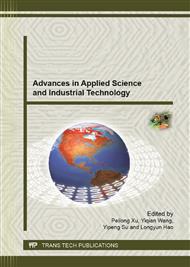[1]
Zhu jun, Wangshi xi: Improved 2D Otsu Algorithm for SAR Image[J], Journal of Image and Graphics, 2009. 01, 14-18.
Google Scholar
[2]
Zhang hong, Wang chao. Zhang bo, Wu fan, Yan dongmei: High resolution of SAR image Target recognition. Beijing: Science press, (2009).
Google Scholar
[3]
Wu junzheng, Yan wei dong, Bianhui: Target Segmentation for SAR Images Based on Nonsubsampled Contourlet Characteristic and PCNN. Opto-Electronic Engineering, 2012(39) 86-92.
Google Scholar
[4]
Guillaume Delyon, philippe Refregier: SAR image segmentation by stochastic complexity minimization with a nonparametric noise model. IEEE transacyions on geosciences and remote sensing, VOL, 44, NO, JULY (2006).
DOI: 10.1109/tgrs.2006.870434
Google Scholar
[5]
Martins, C.I. O: Combining watershed and statistical analysis for SAR Image Segmentation. Proceedings of IEEE, (2006).
Google Scholar
[6]
Ismail Ben Ayed, Carlos Vazquez: SAR image segmentation with active contours and level sets. Proceedings of IEEE , (2006).
DOI: 10.1109/icip.2004.1421665
Google Scholar
[7]
Zhang junmei: The Study of Methods of SAR Image Segmentation[J]. Computer Knowledge and Technology, 2011, 648-650.
Google Scholar
[8]
Li yu, Ji kefeng: Sum up of SAR Image Segmentation technology[J]. Journal of Astronautics, 2008(29). 03, 407-412.
Google Scholar
[9]
Ma xiuli, Jiao li cheng: SAR Image Segmentation Based on Watershed and Spectral Clustering[J]. Journal of Infrared and Millimeter Waves, 2008(27) 452-456.
Google Scholar
[10]
Ni wei ping, Yan wei dong: Bi anhui, SAR Image Segmentation Based on MRF Model and Morphological Operation[J]. Electronics Optics and Control, 2011(18), 33-36.
Google Scholar
[11]
Zhao xiaochuan: Modern digital image processing technology improved and detailed application cases (Version of MATLAB). BEIJING: Beihang university press, (2012).
Google Scholar
[12]
Gonzalez: Digital image processing Second Edition. BEIJING: Publishing electronics industry Press, (2008).
Google Scholar
[13]
Asmare M.H. Asirvadam V.S. Izhar,L. I: Image enhancement : A composite image approach using contourlet transform, Electrical Engineering and Informatics, 2010. International Conference on Volume 01, 5-7 Aug. 2009 Page(s): 135-140.
DOI: 10.1109/iceei.2009.5254801
Google Scholar
[14]
Gonzalez: Digital image processing MATLAB Edition. BEIJING: electronics industry Press, 20.
Google Scholar


